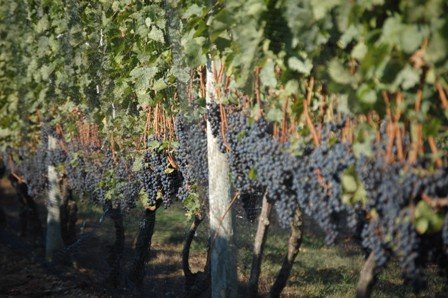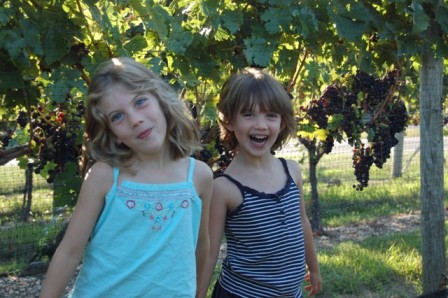|
Sangiovese Italy's wine dates to the Roman's Sangiovese (san-jo-veh-zeh) is a red Italian wine grape variety whose name derives from the Latin sanguis Jovis, "the blood of Jove". Though it is the grape of most of central Italy from Romagna down to Lazio, Campania and Sicily, outside Italy it is most famous as the main component of the blend Chianti, Carmignano, Vino Nobile di Montepulciano and Morellino di Scansano, although it can also be used to make varietal wines such as Brunello di Montalcino, Rosso di Montalcino or Sangiovese di Romagna, as well as modern "Super Tuscan" wines like Tignanello. This young red wine has fresh fruity flavours of strawberry and a little spiciness, but it readily takes on oaky, even tarry, flavors when aged in barrels. It was already well known by the 16th century. Recent DNA profiling by José Vouillamoz of the Istituto Agrario di San Michele all’Adige suggests that Sangiovese's ancestors are Ciliegiolo and Calabrese Montenuovo. The former is well known as an ancient variety in Tuscany, the latter is an almost-extinct relic from the Calabria, the toe of Italy. At least fourteen clones of this red wine grape exist, of which Brunello is one of the best regarded. An attempt to classify the clones into Sangiovese grosso (including Brunello) and Sangiovese piccolo families has gained little evidential support.
Early theories on the origin of Sangiovese dated the grape to the time of Roman winemaking. This was due, in part, to the literal translation of the grape's name as the "blood of Jove"-the Roman Jupiter. It was even postulated that the grape was first cultivated in Tuscany by the Etruscans. The first documented mention of Sangiovese was in the 1590 writings of Giovanvettorio Soderini (also known under the pen name of Ciriegiulo). Identifying the grape as "Sangiogheto" Soderini notes that in Tuscany the grape makes very good wine but if the winemaker is not careful, it risks turning into vinegar. While there is no conclusive proof that Sangiogheto is Sangiovese, most wine historians generally consider this to be the first historical mention of the grape. Regardless, it would not be until the 18th century that this red wine would gain wide spread attention throughout Tuscany, being with Malvasia and Trebbiano the most widely planted grapes in the region. In 1738, Cosimo Trinci described wines made from Sangiovese as excellent when blended with other varieties but hard and acidic when made as a wine by itself. In 1883, the Italian writer Giovanni Cosimo Villifranchi echoed a similar description about the quality of this red grape was being dependent on the grapes it was blended with. The winemaker and politician, Bettino Ricasoli formulated one of the early recipes for Chianti when he blended his Sangiovese with a sizable amount of Canaiolo. In the wines of Chianti, Brunello di Montalcino and Vino Nobile di Montepulciano, Sangiovese would experience a period of popularity in the late 19th and early 20th century. In the 1970s, Tuscan winemakers began a period of innovation by introducing modern oak treatments and blending the grape with non-Italian varietals such as Cabernet Sauvignon in the creation of wines that were given the collective marketing sobriquet "Super Tuscans".
Other techniques used to improve the quality of this red wine include extending the maceration period from 7–12 days to 3–4 weeks to give the must more time to leach vital phenols out of the grape skins. Transferring the wine during fermentation into new oak barrels for malolactic fermentation gives greater polymerization of the tannins and contributes to a softer, rounder mouthfeel. Additionally, this red wine has shown itself to be a "sponge" for soaking up sweet vanilla and other oak compounds from the barrel. For aging the wine, some modern producers will utilize new French oak barrels but there is a tradition of using large, used oak botti barrels that hold five to six hectoliters of wine. Some traditional producers still use the old chestnut barrels in their cellars.
Wines made from Sangiovese tend to exhibit the grape's naturally high acidity as well as moderate to high tannin content and light color. Blending can have a pronounced effect on enhancing or tempering the wine's quality. The dominant nature of Cabernet can sometimes have a disproportionate influence on the wine, even overwhelming this red wine character with black cherry, black currant, mulberry and plum fruit. Even percentages as low as 4 to 5% of Cabernet Sauvignon can overwhelm this type of red wine if the fruit quality is not high. As the wine ages, some of these Cabernet dominant flavors can soften and reveal more Sangiovese character. Different regions will impart varietal character on the wine with Tuscan Sangiovese having a distinctive bitter-sweet component of cherry, violets and tea. In their youth, Tuscan Sangiovese can have tomato-savoriness to it that enhances its herbal component. Californian examples tend to have more bright, red fruit flavors with some Zinfandel-like spice or darker fruits depending on the proportion of Cabernet blended in. Argentine examples showing a hybrid between the Tuscan and California Sangiovese with juicy red fruit wines that end on a bitter cherry note. Sangiovese based wines have the potential to age but the vast majority of this type of red wine are intended to be consumed relatively early in its life. The wines with the longest aging potential are the Super Tuscans and Brunello di Montalcino wines that can age for upwards of 20 years in ideal vintages. These premium examples may need 5 to 10 years to develop before they drink well. The potentially lighter Vino Nobile di Montepulciano, Carmignano and Rosso di Montalcino tend to open earlier (around 5 years of age) but have a shorter life span of 8 to 10 years. The aging potential of Chianti is highly variable, depending on the producer, vintage and sub-zone of the Chianti region it is produced in. Basic Chianti is meant to be consumed within 3 to 4 years after vintage while top examples of Chianti Classico Riserva can last for upwards of 15 years. New World Sangiovese has so far, shown a relatively short window of drinkability with most examples best consume with 3 to 4 years after harvest with some basic examples of Argentine Sangiovese having the potential to only improve for a year after bottling. Thank you Wikipedia for the content on this page
|
Sign up for weekly Red Wine Reviews
CLICK HEREWe will send you the extremely popular Red-Wine-Home tasting terms when you sign-up.






